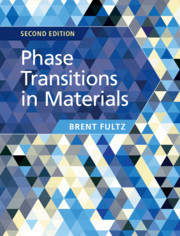Book contents
- Frontmatter
- Contents
- Preface
- Notation
- Part I Basic Thermodynamics and Kinetics of Phase Transformations
- Part II The Atomic Origins of Thermodynamics and Kinetics
- Part III Types of Phase Transformations
- 11 Thermodynamics and Phase Transitions at Surfaces
- 12 Melting
- 13 Solidification
- 14 Phase Transformations with Interfaces: 1. Microstructure
- 15 Phase Transformations with Interfaces: 2. Energetics and Kinetics
- 16 Spinodal Decomposition
- 17 Phase Field Theory
- 18 Method of Concentration Waves and Chemical Ordering
- 19 Diffusionless Transformations
- 20 Thermodynamics of Nanomaterials
- 21 Magnetic and Electronic Phase Transitions
- Further Reading
- References
- Index
21 - Magnetic and Electronic Phase Transitions
from Part III - Types of Phase Transformations
Published online by Cambridge University Press: 24 April 2020
- Frontmatter
- Contents
- Preface
- Notation
- Part I Basic Thermodynamics and Kinetics of Phase Transformations
- Part II The Atomic Origins of Thermodynamics and Kinetics
- Part III Types of Phase Transformations
- 11 Thermodynamics and Phase Transitions at Surfaces
- 12 Melting
- 13 Solidification
- 14 Phase Transformations with Interfaces: 1. Microstructure
- 15 Phase Transformations with Interfaces: 2. Energetics and Kinetics
- 16 Spinodal Decomposition
- 17 Phase Field Theory
- 18 Method of Concentration Waves and Chemical Ordering
- 19 Diffusionless Transformations
- 20 Thermodynamics of Nanomaterials
- 21 Magnetic and Electronic Phase Transitions
- Further Reading
- References
- Index
Summary
The quantum mechanical exchange interaction gives rise to magnetic moments and their interactions in materials, which give rise to patterns and structures in the orientations of magnetic moments at low temperatures. With increasing temperature, pressure, and magnetic field, magnetic structures are altered, and Chapter 21 describes several trends that can be understood by thermodynamics. The critical temperature of magnetic ordering, the Curie temperature TC, is calculated. Compared to chemical ordering, the strengths and alignments of magnetic moments have more degrees of freedom, allowing for diverse magnetic structures. These include ferrimagnetism, frustrated structures, and spin glasses. The vectorial character of spin interactions can give rise to localized spin structures such as skyrmions. An electromechanical phase transition can occur when the energy for a displacement of positive and negative ions in a unit cell is comparable to thermal energies. This ferroelectric transition has some similarities to the ferromagnetic transition, but is described by Landau theory. Domains in ferroelectric and ferromagnetic materials can reduce the energy in surrounding elastic and magnetic fields, andthe width of a boundary between two magnetic domains is estimated.
Keywords
- Type
- Chapter
- Information
- Phase Transitions in Materials , pp. 533 - 564Publisher: Cambridge University PressPrint publication year: 2020



